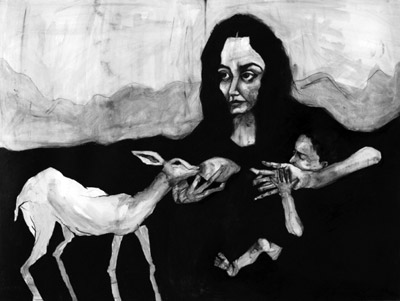When looking at twenty two year old painter Anna Navasardian’s paintings (annanavasardian.com) the first impression is wonder. The depth of impression, cool colors, and the dramatic inner state of her characters are jarring, and you ask yourself “is it possible that the author of these paintings is so young?” Anna lives in the United States where she moved with her family at the age of one. She started painting when she was a child, attended high school for the arts, and later graduated from the College of Fine Art at Carnegie Mellon University.
– So you knew what you wanted to do as a child?
– I have always liked painting and sketching. I used anything available, markers, pens, etc.
– You work on a relatively large scale. Do you have a lot to say?
– You know why? Usually I prefer to paint people. On large canvases figures have more presence. More so, they become part of their environments. My purpose is not to describe the physical attributes of a person but to illuminate at least one moment of their nature and breath. A couple of good moments could be enough for me to know a person. This either happens or not. When I know realize someone’s nature, I want to paint them. Of course sometimes I feel like I’m inventing parts of them.
– Perhaps your not inventing but bringing forth their true nature that they are trying to hide. Could this be the reason that your figures are predominantly “ugly”?
– Your right in someway. I like to dig into the nature of people. I agree that people may not appear beautiful in my paintings, but I don’t think that they are ugly. It’s just one facet of their character, maybe a worry or a fear.
– And you express that through cool colors?
– I see those colors in real life. The color becomes the summary of everything. When I see people I immediately see and feel those colors. I use cobalt blue a lot. Generally I try to simplify colors to strengthen the idea and meaning. Blue denotes coolness and frankness. I often paint people against completely blue surroundings to not distract from the figure. Colors shouldn’t distract from the subject so that the audience can more easily get into the character of the painting.
– Anna, there is so much strife in the faces of your ‘Kids’ series that you intentionally exaggerated. Are you saying that a person carries this strife since childhood?
– I think it is that way. The ‘Kids’ series is about memory, how people remember themselves as children. You know, no matter how old you get you continue remembering and reliving the feelings and thoughts you had as a child.
– Perhaps a person starts to miss himself?
– It is nostalgia. For example, one of the paintings is referencing a traditional class photo. During school years I never liked those photos. Nonetheless I was forced to take them. Everything in them seems superficial. You know what I like, how people present themselves compared to how they actually appear. The difference is interesting to me. I’m addressing the questions of what is embarrassment, what is beauty, why people want to appear a certain way if they are not actually that way, etc. I’m asking these questions through my paintings, but I haven’t found an answer yet. I usually have problems with my subjects when I’m painting them from life. For example, in the ‘Gayla’ painting that is not yet finished [pointing to a painting on the studio wall of a woman-M.M] the woman modeling is constantly correcting me. She says things like it looks nice from this side, that side is too fat, etc. That’s how I get to know people.
– Anna, I have to ask. You are so young but you have a lot to say. Has anyone ever advised you to leave your expressionistic tendencies and start painting what “girls” your age normally paint.
– When a German journalist bought my painting he was surprised at my age. Some people ask me if I’m depressed. By the way, people have been asking me that since I was a child. I have a story. In my eighth grade chemistry class we were given an assignment to reflect on the Hiroshima nuclear bombing. I asked my mom to buy me three Barbies. My parents became worried at a burning smell in the house. They saw that I had basically dismantled these dolls, burned their hair, and glued them to a black and red painting I had made. I presented that project to the teacher. Some time later she called my parents for a meeting and it seemed to her that I was in a deep depression, but that’s how I pictured the heinous scene of a nuclear bombing. When she asked me if I was depressed I asked her if she thought bombings were mild. I was trying to tell the truth. The interesting thing was that for months later she was still talking about my project. I understand that in real life everything is not happy and rainbows. I don’t think its bad because that’s life.

– So what is life?
Happy and sad moments that are both important. I’m not afraid to show everything. Its not always necessary for a painting to be happy.
– Your foremost influence seems to German expressionism. Where does that come from?
– German expressionism is stark and frank. Apparently, that appeals to me. The first strokes are always more honest and genuine. That honesty is so important to me that I feel like I can sacrifice “beauty” for it. Of course art is difficult. I don’t see a separation between it and life. My eyes are always open day and night to know and digest people. It seems to me that the strongest painters live with their work. At home I live with my paintings. I can say in my studio for days.
– In fact, your paintings are already being shown in one of New York’s gallery. How did that happen?
– I came back from art school in Pennsylvania and rented a studio in Brooklyn. It wasn’t the ideal environment (I was sharing the studio space with other artists) but I started to work. After that, I found another space where I could stay day and night and I had the chance to live with my paintings and stare at them for hours even while not working.
At a party my mother attended, she met an art dealer, Tanja Grunert, and told her about my paintings. It happened to be that she has a big gallery in Chelsea, New York. My mother invited her to our house to look at my work. After some calls she agreed to view the paintings. She picked a couple and asked me to bring them to Gasser Grunert gallery. She sold one of my paintings a few days later. That got her interested in my work and she offered me a solo exhibition in the beginning of 2012. Now I’m actively working with Gasser Grunert gallery. I will show about twenty paintings at the exhibition.
– It seems that all your paintings are cohesive and speak about your unique style.
– One of my favorite Armenian painters Edward Kharazyan also said that I have a distinct style. The interesting thing is that before he saw my work he asked me that as a young girl, isn’t anything else I can do besides painting and if I realize how difficult the life of a artist is. When he came to my studio he said “this kid knows what she’s doing.”
– Does academia interfere with creativity?
– I regret that the technical fine art training is so weak in the US. I always wanted to strengthen my technique because I believed that if you have strong technical skills in art then you can go anywhere from there. It took a while to understand that it’s not necessary. Lately I wonder if instead of spending four years in college it would be more beneficial to spend that time and money seeing the world and painting. But I can’t say for certain what would be best.
– Anna, your impression of Armenia seems to have influenced your work especially in the warm colors of your ‘Red Room’ painting. Incidentally, the imagery of the watermelon appears to be significant in your work. What does it represent?
– I have painted watermelons in still lives combined with pictures of women. I guess I find a parallel between pictures of women and watermelons. You wouldn’t know what is inside of a watermelon or what a woman pictured is really like. Watermelons can be red or white on the inside and taste like soap or be very sweet. Paintings of women have so many connotations through art history and everything else so its interesting for me to think of the nature of these women that have been painted over and over again for so many years. What’s on the inside?
– What about the cards?
– To me the cards have an Armenian symbolism to them. It seems that Armenians often use cards to tell about the “future”. The tablecloth is also Armenian to me [pointing to the tablecloth of the ‘Red Room’ painting- M.M.]. I think I did the painting under the influence of Minas Avetisyan. The color red you mentioned reminds me of his red, the intensity of his colors. For me, Minas’s works are very rich. Some of his paintings give me the impression that they took ten years to paint.
– Anna, besides painting you write. Where do you feel more free on the paper or on the canvas?
– Writing for me is much more difficult than painting. I struggle to find simple words. Writing should also be natural and honest but I don’t enjoy it at all.
– Because the colors are lacking?
– Maybe the paper is too small.
– You don’t sign your paintings. Why is that.
A; In art school they told us that signing the face of paintings is old fashioned. Whenever Armenians buy paintings from me they ask me why I don’t sign the face of them. It’s a difference. I sign the backs, I think its less distracting.

